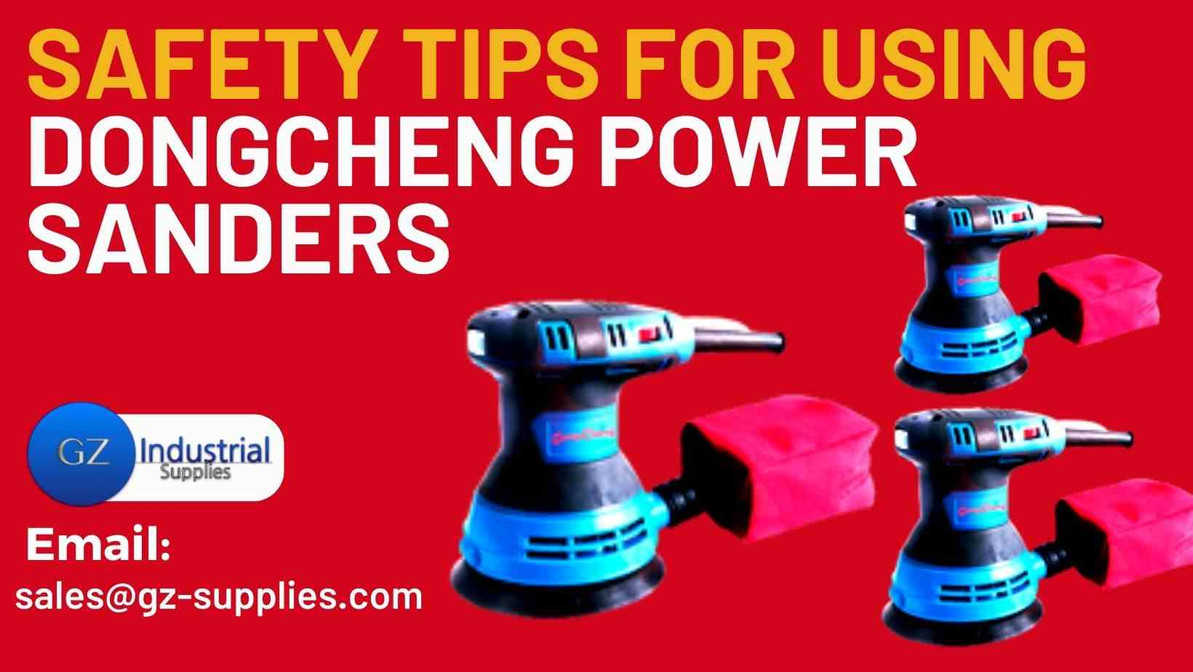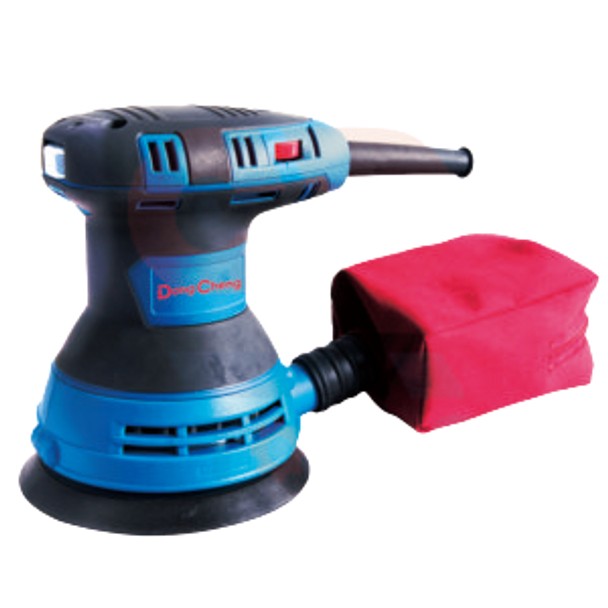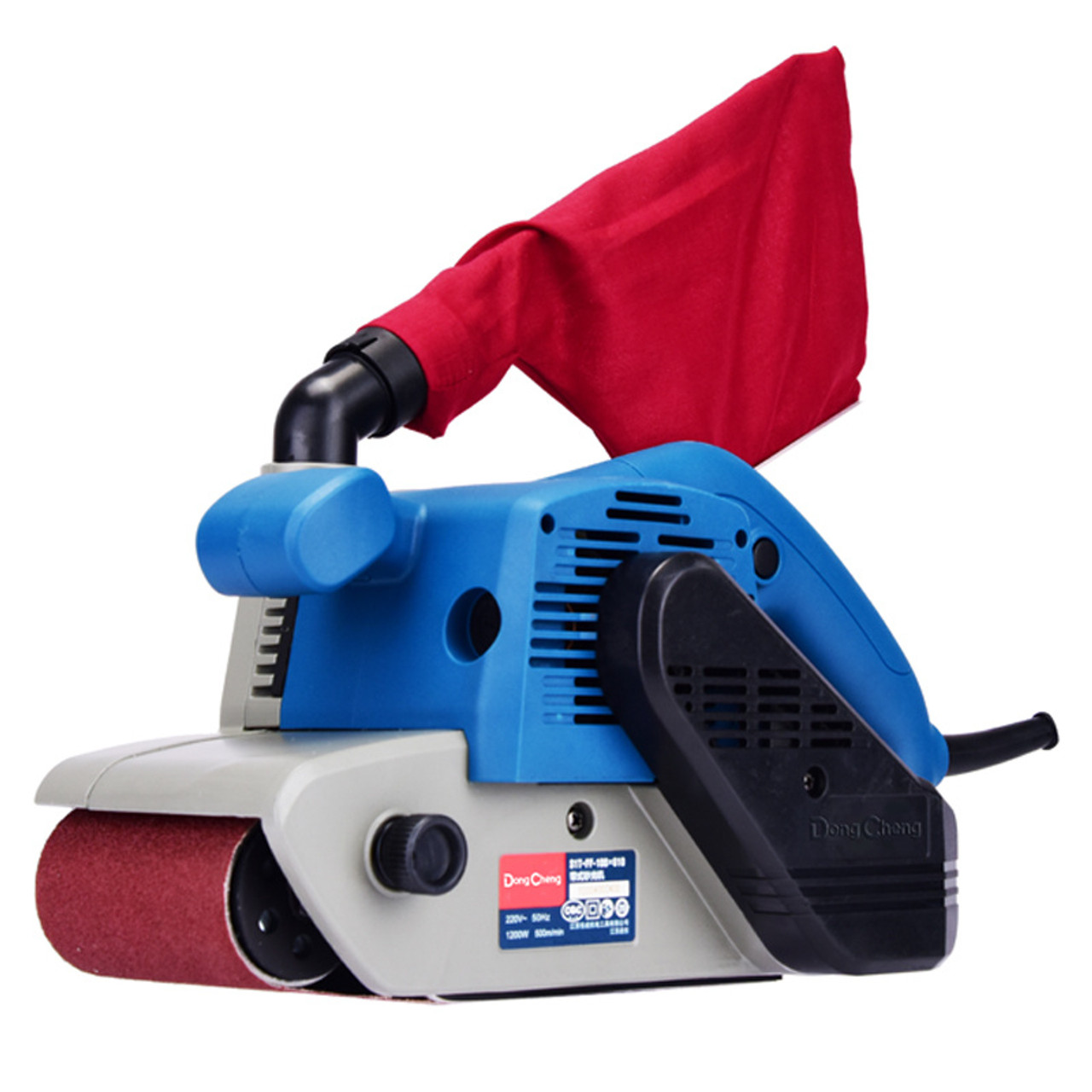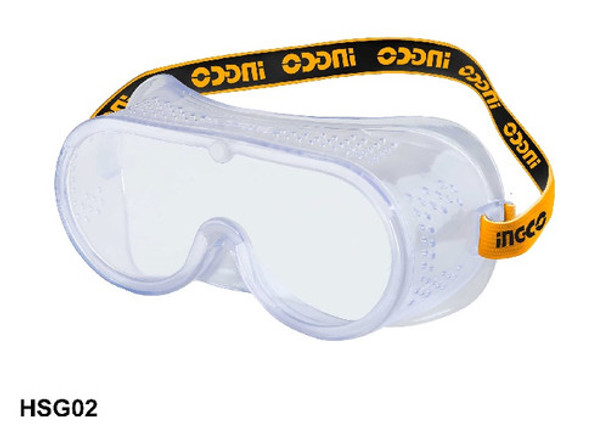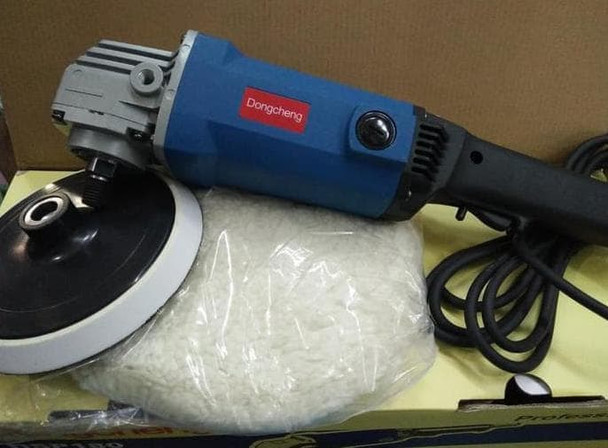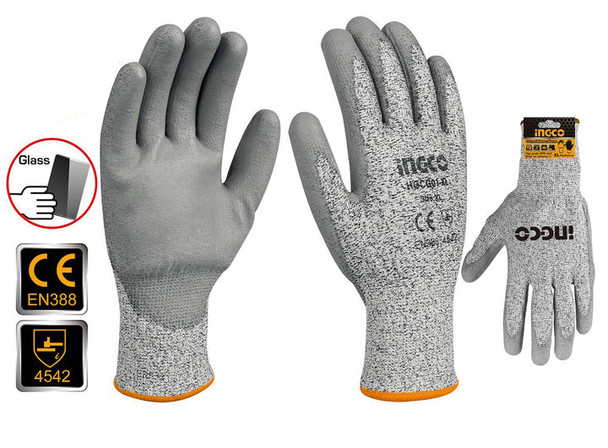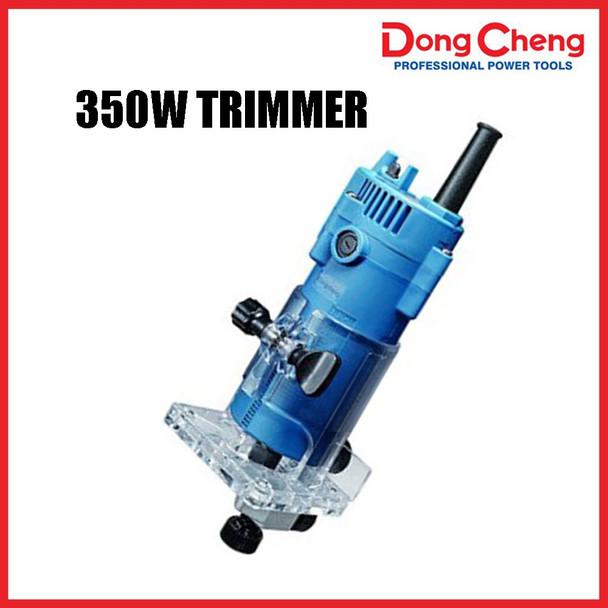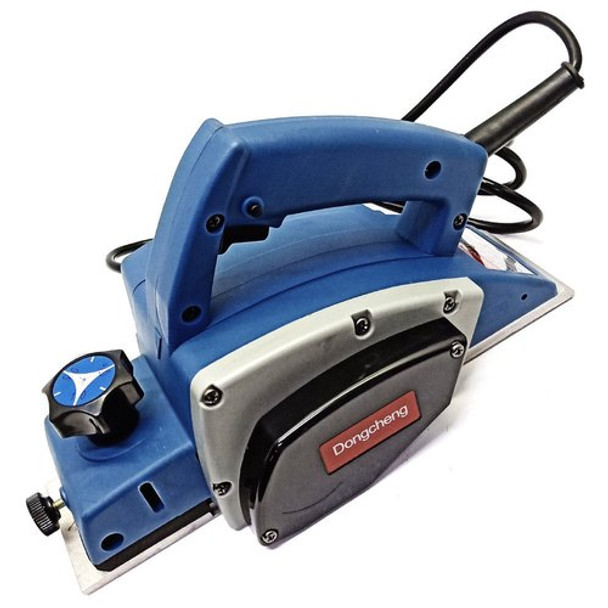Safety Tips for Using Dongcheng Power Sanders
Power sanders are versatile power tools widely used in woodworking and various projects to achieve smooth and refined surfaces. Here are some common uses of power sanders: Power sanders are primarily employed to smooth rough surfaces, whether it's wood, metal, or other materials. They quickly remove imperfections, rough spots, or old finishes, providing a clean and even surface. However, ensuring safety during their use is paramount to prevent accidents and achieve optimal results. This article focuses on Dongcheng power sanders, delving into their features, benefits, and safety measures for users.
Buy Online... DongCheng Random Orbit Sander 300W 125MM DSA125
One of the safety tips when using Dongcheng power sanders is that,ensure to wear appropriate personal protective equipment (PPE), including safety glasses to shield your eyes from debris and dust, and ear protection to minimize noise exposure. Dongcheng, a renowned brand in power tools, is known for producing high-quality equipment, including power sanders that cater to a wide range of applications.
This comprehensive guide will explore the importance of safety when utilizing power sanders, specifically from the Dongcheng lineup. From understanding the key features to mastering safety protocols, we'll cover everything you need to know to make the most of your power sanding tools. Stay tuned for valuable insights and expert tips on optimizing your woodworking experience with Dongcheng power sanders.
Know Your Dongcheng Power Sander
Before you start using your Dongcheng power sander, it is important to familiarize yourself with its features and functions. Dongcheng is a leading brand of power tools that offers a range of sanders for different purposes and applications. Here is some basic information about Dongcheng power sanders and their types/models.
Dongcheng power sanders are electric or battery-powered tools that use abrasive paper or discs to smooth, polish, or remove material from various surfaces. Depending on the type of sander, the sanding pad can move in different ways, such as rotary, random orbit, or belt. Dongcheng offers several types of power sanders, such as:
- Orbital sanders: These sanders have a sanding pad that moves in small, irregular circles. They are good for general-purpose wood finishing and can reach tight corners and edges. Dongcheng has several models of orbital sanders, such as the DSA125.
- Belt sanders: Belt sanders have a continuous loop of sandpaper that runs over two rollers. They are good for deep sanding and wood removal, especially on large, flat surfaces. Dongcheng boasts excellent models of belt sanders like the DST610.
- Electric planers: These sanders have a blade that cuts thin shavings from the surface of the wood. They are good for leveling and smoothing uneven or rough surfaces. Dongcheng has a few models of electric planers, DMB82, DMB02-82 and DMB03-82.
- Trimmers: These sanders have a small, round sanding pad that can be used for trimming, shaping, and carving wood. They are good for detail work and fine finishing. A good example of Dongcheng models of trimmers is the DMP02-6.
- Wood routers: These sanders have a spinning bit that can cut grooves, edges, or patterns on wood. They are good for creating decorative and functional designs on wood. Dongcheng has several models of wood routers, such as the DMR8, DMR06-12.
- Sanders polishers: These sanders have a large, round sanding pad that can be used for polishing and buffing various surfaces. They are good for enhancing the shine and smoothness of wood, metal, or plastic. Dongcheng has several models of sanders polishers like the DSP180.
Buy Online... DongCheng Belt Sander 1200W 610MM DST610
Although different types of power sanders may have different designs and functions, they all share some common components and features, such as:
- Power switch: Button or lever that turns the sander on or off. It is usually located on the handle or the body of the sander.
- Speed control: Usually a dial or knob that adjusts the speed of the sanding pad. It is usually located near the power switch or on the side of the sander.
- Dust collection: This is the system that collects the dust and debris generated by the sanding process. It can be a bag, a box, a filter, or a port that connects to a vacuum. It is usually located at the back or the bottom of the sander.
- Sandpaper or disc: The abrasive material that attaches to the sanding pad. It can be a sheet, a roll, a disc, or a belt. It can have different grits, which indicate the roughness or fineness of the sandpaper. The lower the grit number, the rougher the sandpaper. The higher the grit number, the finer the sandpaper. It is usually attached to the sanding pad by velcro, clamps, or screws.
- Sanding pad: This is the part of the sander that holds the sandpaper or disc and moves in a certain way. It can be rectangular, square, circular, or belt-shaped. It can move in rotary, random orbit, or belt motion. It is usually connected to the motor by a shaft or a belt.
Importance of reading the user manual
Before you use your Dongcheng power sander, it is essential to read the user manual that comes with it. The user manual contains important information and instructions on how to operate, maintain, and troubleshoot your sander. It also provides safety tips and warnings that you should follow to avoid injury or damage. Some of the topics that the user manual covers are:
- How to assemble and disassemble your sander
- How to attach and change the sandpaper or disc
- How to adjust the speed and direction of the sanding pad
- How to use the dust collection system
- How to clean and store your sander
- How to identify and solve common problems with your sander
- How to contact customer service or warranty support
Personal Protective Equipment (PPE) when using Dongcheng Power Sanders
Using power sanders can expose you to various hazards, such as flying debris, dust, noise, vibration, and electric shock. To protect yourself from these risks, you need to wear appropriate Personal Protective Equipment (PPE) whenever you operate a power sander. Here are some essential PPE items for safe power sander operation:
List of essential PPE for safe power sander operation
- Safety goggles or glasses: These protect your eyes from flying debris, dust, or sparks that may be generated by the sanding process.
- Dust mask or respirator: These protect your lungs from inhaling dust, fumes, or vapors that may be produced by the sanding process. They should fit tightly and cover your nose and mouth. Choose the right type of mask or respirator for your intended purpose. For example, a simple dust mask may be sufficient for sanding wood, but a respirator with a filter may be required for sanding metal or paint.
- Hearing protection: These protect your ears from the loud noise that may be emitted by the power sander. Make the choice between ear plugs or ear muffs, depending on your preference and the type of sander you are using.
- Work gloves: These protect your hands from cuts, abrasions, or burns that may be caused by the sanding process. They should be durable, flexible, and fit well.
- Appropriate clothing and footwear: These protect your body and feet from injuries that may be caused by the sanding process. You should wear clothing that is snug-fitting, non-flammable, and free of loose or dangling parts that may get caught in the sander. Also wear footwear that is sturdy, slip-resistant, and covers your toes. Avoid wearing jewelry, watches, or rings that may conduct electricity or get caught in the sander.
Buy Online... INGCO Safety Goggle HSG02
Wearing PPE is not a one-time thing. You need to wear it consistently and correctly every time you use a power sander. This means that you should:
- Check your PPE before each use and make sure it is in good condition and fits properly.
- Replace or repair any damaged or worn-out PPE as soon as possible.
- Clean and store your PPE after each use and follow the manufacturer’s instructions for maintenance.
- Do not share your PPE with others or use someone else’s PPE without proper cleaning and disinfection.
- Do not remove or adjust your PPE while using the power sander or expose it to unnecessary hazards.
By wearing PPE consistently, you can reduce the risk of injuries and illnesses that may result from using power sanders. You can also improve your comfort and performance and enjoy your sanding projects more. Remember, PPE is your last line of defense against hazards, so don’t take it lightly.
Power Sander Inspection and Maintenance
To keep your power sander in optimal condition and extend its lifespan, you need to perform regular inspection and maintenance. Here are some basic steps for inspecting and maintaining your power sander:
Regularly check the condition of the power sander
Regular inspection of your Dongcheng power sander is essential to ensure its optimal performance and your safety. Here's a checklist for a thorough examination:
- Sanding Pad or Belt: Inspect for any signs of wear, damage, or unevenness. Replace if necessary to maintain effective sanding.
- Power Switch and Controls: Ensure the power switch and other controls are functioning properly. Check for any loose or damaged components that may affect the tool's operation.
- Power Cord: Examine the power cord for cuts, frays, or exposed wires. Any damage to the cord can pose a significant safety risk and should be addressed immediately.
- Dust Collection System: Verify that the dust collection system is working efficiently. Clean or replace filters as needed to maintain optimal dust extraction.
- Motor Housing: Check for any visible damage or signs of overheating. Ensure proper ventilation to prevent the motor from overheating during extended use.
- Vibration and Noise Levels: Monitor for any unusual vibrations or changes in noise levels during operation. Excessive vibration may indicate an issue with internal components.
Buy Online... DongCheng Polisher 750W 180MM DSP180
Lubricate and clean the sander
Proper maintenance, including lubrication and cleaning, extends the life of your power sander and ensures consistent performance. Follow these steps:
- Lubrication: Apply lubricant to any moving parts as specified in the user manual. This includes the bearings, gears, and any other components that require lubrication. Regular lubrication minimizes friction and reduces wear.
- Dust Removal: Clean the sander regularly to prevent dust buildup. Dust can affect the tool's efficiency and, over time, cause damage to internal components. Use a soft brush or compressed air to remove dust from vents and moving parts.
- Ventilation Openings: Keep ventilation openings clear of debris to ensure proper air circulation. Restricted airflow can lead to overheating and reduced performance.
- Sanding Surface: Clean the sanding surface to remove any adhesive residue or buildup. A clean surface ensures consistent and efficient sanding.
Ensure the power cord and plug are in good condition
The power cord and plug are essential for the safe and efficient operation of your power sander. To ensure that they are in good condition, you should:
- Avoid twisting, bending, or kinking the cord, as this may cause damage or breakage.
- Avoid pulling or yanking the cord, as this may loosen or detach the plug or the connections.
- Avoid exposing the cord or the plug to heat, moisture, oil, or sharp objects, as this may cause deterioration or fire hazards.
- Use an extension cord that is suitable for the power and length of your tool, and avoid using multiple extension cords or adapters, as this may cause voltage drop or overload.
- Unplug the tool when not in use, and store the cord and the plug in a dry and cool place, away from direct sunlight or sources of heat.
Learn More: Choosing the Right Woodworking Power Tools for Your Projects
Operating the Dongcheng Power Sander Safely
Using a power sander can be easy and efficient, but it also requires some skill and caution. To operate your Dongcheng power sander safely, you need to follow some basic Safety Tips and best practices, such as:
Buy Online... INGCO HGCG01-XL Cut Resistance Gloves
Proper hand positioning and grip
- Hold the power sander firmly with both hands, using the handles or grips provided by the tool. Do not hold the tool by the body or the cord.
- Keep your fingers away from the sanding pad, the sandpaper, or the workpiece, as they may get injured by the abrasive or the heat.
- Adjust your grip according to the type and size of the sander, the direction and angle of the sanding, and the shape and texture of the workpiece. For example, for orbital sanders, you may need to use one hand to hold the handle and the other hand to support the front of the tool.
Correct sanding techniques and patterns
- Always turn the sander on before placing it in contact with the workpiece and keep the sander moving to prevent burning while sanding.
- Apply even and consistent pressure on the sander, but do not press too hard or too lightly. Too much pressure may cause the sander to slow down, overheat, or damage the workpiece. Too little pressure may cause the sander to bounce, vibrate, or produce uneven results.
- Follow the grain of the wood when sanding, and avoid cross-grain or diagonal sanding, as this may cause scratches or swirl marks.
- Use a smooth and steady motion when sanding, and avoid jerky or erratic movements. Make sure the sanding pad is parallel to the workpiece and does not tilt or wobble.
- Overlap the sanding strokes slightly to ensure a uniform finish and avoid gaps or ridges.
Maintaining control and balance while sanding
- Keep your body and posture stable and comfortable while sanding, and avoid overreaching or bending awkwardly. Use a stool, a ladder, or a scaffold if you need to sand at a high or low level.
- Keep your balance and footing secure while sanding, and avoid slipping or tripping on the cord, the dust, or the workpiece. Use a rubber mat, a clamp, or a vise if you need to sand on a slippery or unstable surface.
- Keep your eyes and attention focused on the sanding task, and avoid distractions or interruptions.
Avoiding excessive pressure on the sander
- Do not force the sander to do more than it is designed for, such as sanding a material that is too hard, too thick, or too rough for the tool. Use the appropriate type and model of sander for the job, and consult the user manual for the specifications and limitations of the tool.
- Do not overload the sander by using a sandpaper that is too coarse, too fine, or too worn for the task.
- Do not overwork the sander by using it for too long or too frequently without a break. Give the tool some rest and cooling time between sanding sessions, and avoid continuous or prolonged use of the tool.
Handling different sandpaper grits appropriately
- Start with a coarse grit sandpaper to remove the bulk of the material and the major defects, such as scratches, dents, or stains. Gradually move to finer grits to smooth and polish the surface and remove the marks left by the previous grits.
- Use a sandpaper that matches the size and shape of the sanding pad, and attach it securely and correctly to the tool. Do not use a sandpaper that is too large, too small, or misaligned, as this may cause the sandpaper to tear, fold, or slip.
- Store and handle the sandpaper carefully, and avoid exposing it to moisture, heat, or dust. Keep the sandpaper flat and smooth, and do not bend, crease, or crumple it. Use a protective case or a plastic bag to store the sandpaper when not in use.
Buy Online... DongCheng Trimmer 6.35 mm, 350 W DMP02-6
Emergency Procedures
Using a power sander can be dangerous if you are not careful or prepared. Accidents or injuries can happen at any time, and you need to know how to deal with them quickly and effectively. Here are some emergency procedures that you should follow in case of an accident or injury:
Steps to take in case of an accident or injury
- Stop the power sander immediately and unplug it from the power source. Do not touch the tool or the workpiece until they are completely stopped and cooled down.
- Assess the severity and type of the injury, such as a cut, a burn, a bruise, or a sprain. If the injury is minor, treat it with the appropriate first aid measures, such as cleaning, bandaging, or icing the wound.
- If the injury is serious, such as a deep or large cut, a severe burn, a fracture, or a concussion, call for emergency medical assistance or go to the nearest hospital as soon as possible. Do not attempt to move or treat the injured person unless you are trained and qualified to do so.
Importance of having a first aid kit and emergency contact information on hand
A first aid kit is a collection of supplies and equipment that can be used to provide basic medical care for minor injuries or illnesses. A first aid kit should be easily accessible and well-stocked with items such as bandages, gauze, antiseptic, scissors, tweezers, gloves, and painkillers. Emergency contact information on the other hand, is a list of phone numbers or addresses that can be used to reach someone who can help in case of an emergency. Emergency contact information should include the numbers of local emergency services, such as the fire department, the police, or the ambulance, as well as the numbers of your family, friends, or coworkers who can assist you or notify others about the situation.
Having a first aid kit and emergency contact information on hand is important because it can help you prevent further complications, reduce pain and suffering, and save time and lives in case of an accident or injury. You should always check and update your first aid kit and emergency contact information regularly, and make sure they are visible and accessible to anyone who may need them.
Buy Online... DongCheng DMB82 Electric Planer 16000r/min,255mm
Related Articles.
Where to Buy DongCheng Professional Power tools in Abuja
POWER TOOLS SAFETY MEASURES FROM INJURIES
WHAT YOU NEED TO KNOW ABOUT THE DONGCHENG CORDLESS TOOL BATTERY PACK
Conclusion
Using Dongcheng power sanders can make your woodworking or sanding projects easier and faster, but it also comes with some risks and responsibilities. To use your power sander safely and effectively, you need to ensure you:
- Know your Dongcheng power sander and its features and functions
- Wear appropriate Personal Protective Equipment (PPE) whenever you operate a power sander
- Inspect and maintain your power sander regularly and properly
- Operate your power sander with care and caution, following the correct sanding techniques and patterns
- Follow the emergency procedures in case of an accident or injury, and seek medical attention for serious injuries
By following these safety tips, you can prevent or minimize the chances of injuries, damages, or poor results that may occur due to using power sanders. You can also enjoy your sanding projects more and achieve better outcomes. Remember, safety is not an option, but a priority, when it comes to using power tools. So, always put safety first. For more information or enquiries about Dongcheng Power Sanders, don't hesitate to Contact Us Today.
Recent Posts
-
Press Release: Same Great Lube, Less Waste: Lubemax 50:50 makes the Switch to Sustainable Packaging
In a move towards environmental responsibility, Epoxy Oilserv Nigeria Limited is proud to announce t …Apr 23, 2024 -
Top 8 Generators Recommended by Professionals in Nigeria (Reviews)
Generators can keep your home or business running with your essential equipment until the power is b …Apr 23, 2024 -
Transformer Safety: Preventing and Managing Common Hazards
Transformers are critical components in the electrical distribution system, handling high volt …Apr 23, 2024

